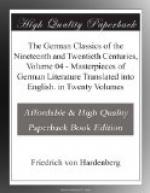The views or suggestions of feeling by which he was guided in the use of rhyme may likewise be traced with almost equal certainty. Not infrequently scenes, or even single speeches, close with a few rhyming lines, for the purpose of more strongly marking the division, and of giving it more rounding. This was injudiciously imitated by the English tragic poets of a later date; they suddenly elevated the tone in the rhymed lines, as if the person began all at once to speak in another language. The practice was welcomed by the actors from its serving as a signal for clapping when they made their exit. In Shakespeare, on the other hand, the transitions are more easy: all changes of forms are brought about insensibly, and as if of themselves. Moreover, he is generally fond of heightening a series of ingenious and antithetical sayings by the use of rhyme. We find other passages in continued rhyme, where solemnity and theatrical pomp were suitable, as, for instance, in the mask,[30] as it is called, in The Tempest and in the play introduced in Hamlet. Of other pieces, for instance, the Midsummer Night’s Dream, and Romeo and Juliet, the rhymes form a considerable part; either because he may have wished to give them a glowing color, or because the characters appropriately utter in a more musical tone their complaints or suits of love. In these cases he has even introduced rhymed strophes, which approach to the form of the sonnet, then usual in England. The assertion of Malone, that Shakespeare in his youth was fond of rhyme, but that he afterward rejected it, is sufficiently refuted by his own chronology of the poet’s works. In some of the earliest, for instance in the second and third part of Henry the Sixth, there are hardly any rhymes; in what is stated to be his last piece, Twelfth Night, or What You Will, and in Macbeth, which is proved to have been composed under the reign of King James, we find them in no inconsiderable number. Even in the secondary matters of form Shakespeare was not guided by humor and accident, but, like a genuine artist, acted invariably on good and solid grounds. This we might also show of the kinds of verse which he least frequently used (for instance, of the rhyming verses of seven and eight syllables), were we not afraid of dwelling too long on merely technical peculiarities.




